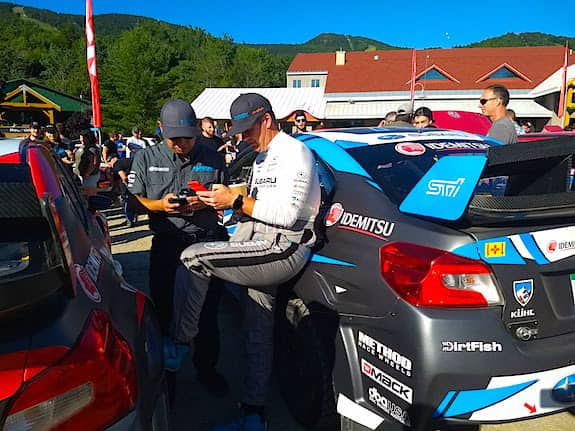
Here’s the world-class driver David Higgins. You get to walk right up and shake his hand at the New England Forest Rally. Copyright 2018 Tim Carter
Author’s Note: If you’ve come here from the July 2023 article in QST looking for the recording of our 80-meter NVIS test, it’s far below. Go ahead and read this article to get a REAL FEEL of what the New England Forest Rally is all about.
New England Forest Rally – Emergency Training Ground
Imagine you’re called upon to use your radio skills to help your community in an emergency. Here’s the scenario you’re faced with:
You and four other radio operators are deployed to an area with no cell phone coverage and no services. A town has been cut off from civilization by some natural disaster and you need to collect and transmit valuable data. You’re tasked with taking everything you need to communicate for hours on end in any weather.
Your most important job is to record data on a minute-by-minute basis that could save someone’s life. You need to be able to hear your team members and they need to hear from you. Your group may be spread out in an area as large as twenty square miles. Your notes must be perfect. Rain, heat, dust, and darkness can’t hinder you.
It gets more complex. You need to transit miles across bumpy dirt roads to this location, set up your equipment in the open with no shelter, work for a few hours and then quickly break down because now the local authorities decide your skills are needed at another emergency site.
You and your team are expected to pack up all your gear and travel to the second, and possibly a third, location and be set up at a specified time. You can’t be late. People’s lives are at stake. You must be able to communicate at these unknown locations no matter the weather or any other conditions. You might do this for twelve or more hours for two or more days.
How would you hone your outdoor radio skills to be able to do all of the above? I do it every summer at the New England Forest Rally (NEFR).
WATCH THIS VIDEO to discover all you need to know about the NEFR:
What is the New England Forest Rally?
The NEFR is a two-day automotive rally that unfolds on both asphalt and dirt logging roads of Western Maine and Northern New Hampshire.
It’s sanctioned by the American Rally Association and happens in July of every year. Professional drivers from across the world come to race with local people like you that want to drive fast.
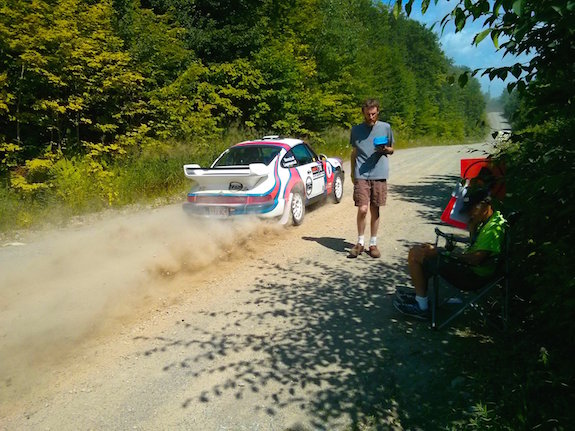
A high-performance race car spits gravel and sand leaving the start line. Ryan Freise, KB1VLC, releases the cars paying attention to a special hand-held race timer. Copyright 2017 Tim Carter
Do You Have a Podcast About the NEFR?
Well, I did a 45-minute talk about the NEFR at the 2019 Boxboro, MA HamExposition. I shared in the talk what you need and how it will transform you into a better radio operator. CLICK or TAP HERE for the PowerPoint presentation. Here’s the matching audio for the talk:
Do They Race in the Rain?
Whatever weather Mother Nature serves up is what everyone deals with. It can be rainy and cool or blistering hot and humid. Bugs of all types are always present and plentiful. Dust is a given – lots and lots of dust.
What Kind of Cars Are in the Race?
This two-day event features high-performance race cars that might zoom down narrow roads at speeds in excess of 100 miles per hour. Cars drifting around corners, going airborne over jumps and creating giant clouds of dust are commonplace. It’s action-packed and you’re guaranteed to come away from the NEFR, or a similar rally, with a sense of enormous accomplishment.
Who are the Race Drivers?
The NEFR has an eclectic mix of world-class drivers like Travis Pastrana, David Higgins, and Ken Block. You can even race in the event yourself if you can produce a car that contains all the safety equipment and you pay the entrance fee. You don’t have to have a huge sponsor like Subaru, Ford, or Maxxis behind you.
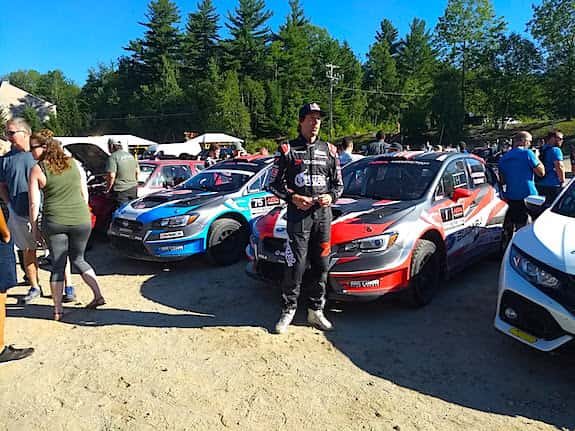
Here’s Travis Pastrana greeting fans in the parc expose’ before the drivers leave to race for the day. Copyright 2018 Tim Carter
Here’s a video I shot in 2017 of the winner of the event, Travis Pastrana. Listen to his engine RPMs spike at 0:17!
How Many Races Happen in Two Days?
Over the two days, there are no less than 13 individual races. Rally organizers call them stages. The stages may range in length from 4 to 16 miles long.
Are the Rally Cars Special?
The rally cars are special. But it gets more complex. The race cars must be street legal and they have to transit across public roads at legal speed limits in a tight time window from one stage to the next. Failure to make it to the next stage on time causes a driver or team to lose points.

Here’s some of the gorgeous scenery you’ll pass as you transit between stages as you get ready for your next assignment. Copyright 2017 Tim Carter
What Do Radio Operators Do?
As an amateur radio operator, your job is to create and maintain a vital safety communications net over each stage. The drivers, teams, race organizers and spectators need your skills so they can get help in the event of a crash or breakdown.
Your skills may be required if a spectator has a medical emergency.
You must be able to be heard when you transmit and you must be able to hear all other operators on the stage. CLICK or TAP HERE to see the best radio equipment setup for the NEFR.
Your duties during an active stage are to record the car numbers and the time they leave the starting line. The radio operator at the start line announces this seconds after each car speeds out onto the stage.
As each car passes you, you must note in your log it passed and the time it passed. It’s very possible for cars to get out of order as one car may pass another or a car may have temporary difficulty on the course and be delayed several minutes.
In the worst case, a car can crash and go off the road and no one really knows about this until the car fails to cross the finish line. Rescue teams will begin to search for the car and driver/co-driver beginning at the last radio operator who logged it passing.
As you can see, you need to be in the moment and you must be able to record data accurately. Forget about fumbling with a cell phone to record the time. Use an old-fashioned wristwatch for goodness sake.
Are Radio Operators in Charge of Official Car Race Times?
No. The official time from start to finish of each car on each stage is recorded electronically using special equipment. Radio operators are relieved of this responsibility.
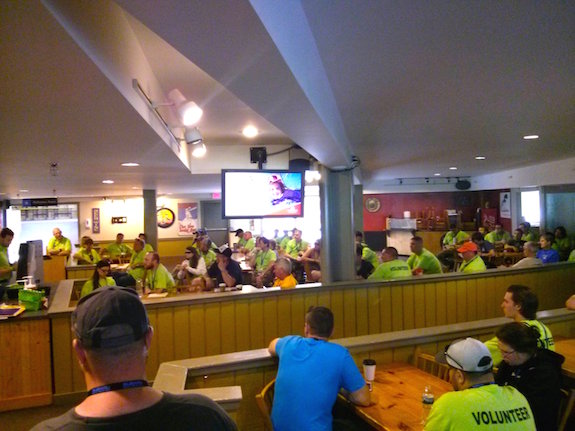
All radio operators and many other volunteers must attend a mandatory meeting on the first morning. Copyright 2017 Tim Carter
Where are Radio Operators Positioned?
Radio operators are placed at the start and finish lines and at other strategic locations along each stage. Each operator must be able to hear the start-line operator and log accurately the sequence of the car numbers as each car zooms away from the starting line.
As each car passes an operator, she/he needs to log the car sequence number, the number of the car printed on the doors, and the time it passes. I’m sure you can see the importance of this in case cars begin to pass a location out of sequence. An out-of-sequence car could mean the missing car has crashed and been swallowed up by the deep forest.
The accurate logs allow the race officials to determine where the missing competitor might be in the case other drivers have not reported a car in trouble.
What Equipment Does a Radio Operator Need?
I’ve worked the NEFR for no less than five years. It’s one of my favorite public service events because of the high-octane thrills and the challenges.
I feel there’s a good, better and best way to equip yourself should you want to come join the fun.
It’s possible to be an effective operator using just a regular handheld radio. You’ll need every bit of your five watts and a quarter-wave 2M antenna would be ideal. This past year I worked with an operator from Massachusetts that had a Chinese HT and a 6-inch-long rubber antenna. Surprisingly he was able to do very well with that setup.
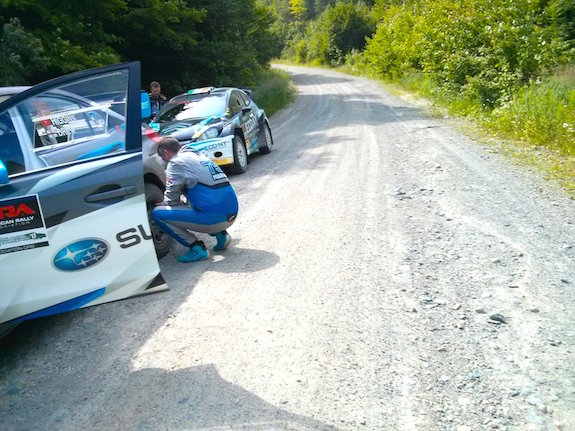
David Higgins, a world-class driver from the UK, is checking his tire pressure before he starts a race. This is a 600+ horsepower car. He and all other drivers and co-drivers are counting on you to save them if something goes horribly wrong. Copyright 2017 Tim Carter
In just about every location you’re at on a stage at the NEFR, you’ll probably have access to a nearby tall tree. I feel it’s better to connect your HT to a roll-up j-pole antenna made from common 300-ohm feed line. If you can make one from 450-ohm ladder line, it will probably perform a little better.
You can use a simple water bottle to get a thin string up into a tree branch. Use this string halyard to quickly pull up your j-pole. This antenna up 25 or 30 feet in the air will give you an enormous advantage.
The best setup, in my opinion, is to have a mobile radio in your car or truck that’s got 50 or more watts of power. It’s vital this radio has cross-band repeater functionality. Often you need to be standing away from your parked car or truck to be in a safe position and have great visibility of the race course.
My Yaseu FT-8900 has this simple magical cross-band repeat feature that allows me to use very low power on my HT set at a 70-centimeter frequency going into the 8900, but the mobile radio blasts out my signal on the 2M stage frequency so all can hear. With my HT set on low power, it sips juice from its battery so I know I’ll have power all day long.
If you pair this higher-powered mobile radio with a tall antenna in a tree or mast support near the truck, you’ll be heard and will hear everything.
Do Radio Operators Have to Set Up and Takedown?
The second day of the NEFR is always a test. There are at least three radio teams and the team you’re assigned to may have to work three different stages on the same day.
You might meet at 6:30 am and begin to drive 50 miles to get to where you need to set up. After that stage is complete, you’ve got to hurry and break down all your equipment, load up and move to relocate to the next stage. I’ve worked thirteen hours straight on certain days. It’s fun but exhausting.
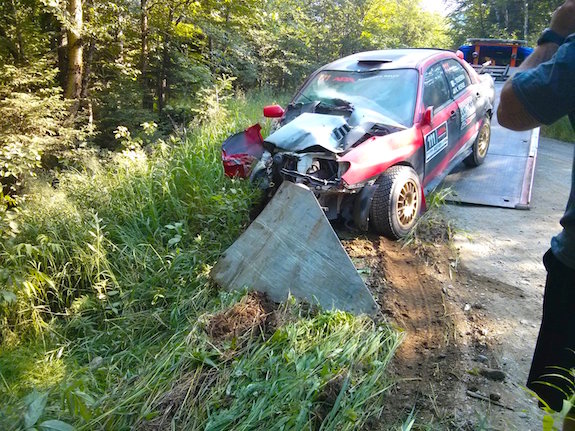
Crashes are a normal event during a rally. You need to be in a safe location out of harm’s way. The driver of this car escaped with bumps and bruises. His co-driver fractured her pelvis. Your skills on the radio can help these people. Copyright 2017 Tim Carter
Operators and other stage workers caravan together as they move to the next stage and it’s quite exciting.
Do Accidents Happen at the NEFR?
Yes, accidents happen and some can be serious. Ken Block’s car caught on fire and was completely destroyed in the 2018 NEFR.
Some are so serious that they make national news. You could have been the radio operator who called in the Ken Block car fire that happened at the NEFR in 2018. This incident made the national news.
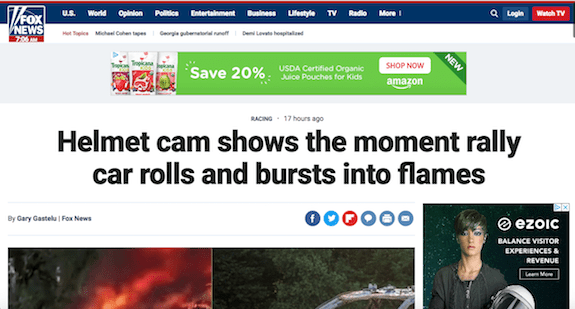
The Ken Block crash made national news. Imagine you being the operator just 100 feet away that called in the emergency! Copyright 2018 Fox News, Inc.
Local towns provide ambulance services in case a crash goes wrong.
It’s a good idea to equip yourself with a fire extinguisher, multiple sealed five-gallon buckets of water, a first aid kit, shovels, weed whackers, an ax, or any other tool you think you may need to help save yourself or someone else in the woods.
The Boy Scout motto, Be Prepared, is of paramount importance in this event. You could find yourself all alone trying to extract someone from a burning car in the worst-case scenario.
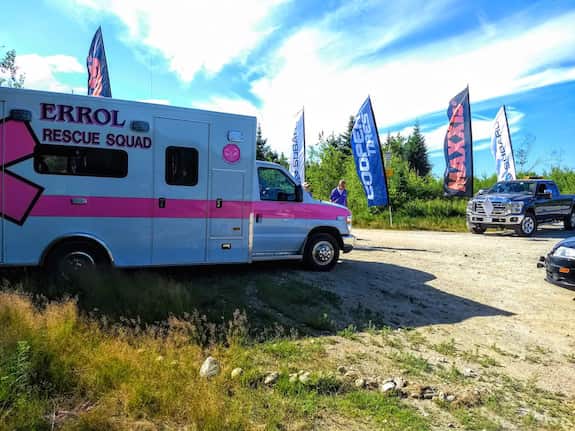
Here’s an ambulance parked at the end of Stage 13, North Road, in case it’s needed. In 2017, a co-driver fractured her pelvis in a crash, so highly trained EMS people are needed. Copyright 2018 Tim Carter
What About 80-Meter NVIS?
We now use 80-meter NVIS antennas on two of the stages. CLICK or TAP HERE to discover more and to listen to our actual test of NVIS on the South Arm stage that had been a problem for nearly 30 years.
What’s In It For You
If I’ve not already answered that subliminal question roiling around in your head, “What’s in this for me Tim? Why should I go out and battle the dust and bugs?”, then I’ll finish with this.
Not only do you get a swell event t-shirt that commemorates your service and sacrifice, but you also get to meet some very interesting fellow radio operators from around the region. You can walk up and converse with world-class rally drivers that travel from around the world to race on these epic gravel roads.
But wait, there’s more! If you’re lucky enough to get assigned to the epic Aziscohos stage like I was, bring your bathing suit! Just 1.3 miles from the start line is a hidden jewel of a stream with three or four personal swimming holes about the size of a hot tub.
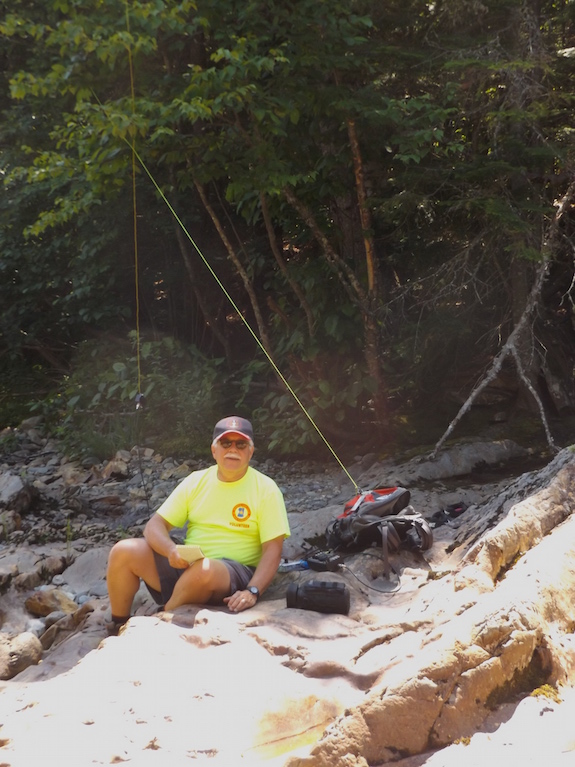
Tim Carter, W3ATB, completing an HF QSO from the center of the magical stream on the Aziscohos stage of the NEFR. Just upstream are three delightful swimming holes! Copyright 2017 Gary Thomas
This stage is normally run twice with a three-hour break between the two races. That’s plenty of time to get in a great relaxing swim or break out your outdoor HF radio and make a few quick QSOs as I did.
If you need further encouragement to come to join the fun, feel free to reach out to me. If you live somewhere other than the Northeast USA, believe me, there are rally races like the NEFR very close to where you are. Just go online and look for them. I guarantee you they need your skills and you’ll not regret going.
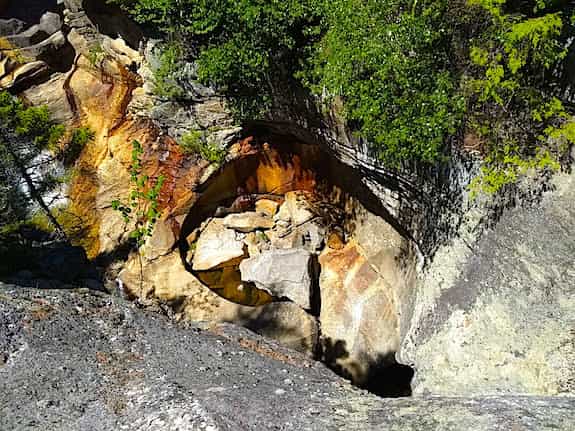
This is the tall falls created by continental glacial meltwater at Grafton Notch State Park. It’s one of the scenic places you can visit between races. Copyright 2018 Tim Carter

Pingback: Outdoor Ham Radio | W3ATB
Pingback: Synchronicity and Jason - Perfect Home Digest
Pingback: Squelch Ham Radio and NEFR | W3ATB
I have two for you, My self, I have done the rally many times in the past including the winter rally several times. I drove for Tom Grimshaw during one winter rally. It has been quite a few years and I would like to have a go at it again. We used to start from the Rumford Inn back then but Sunday River make more sense. I am N3LYT my friend has done coms for Lime rock and the VSCCA we both have done the Equinox hill climb several times Her name is Barbra, KD2FZU so feel free to contact me we are looking forward to the race this year.
If you are ever looking for another volunteer Ham I might be interested. I have a family camp in Dix Grant (north of Errol) so I’m familiar with the race.
I do communications with The Prouty event each year in Hanover NH. I have mobile VHF and UHF Ham, mobile VHF Public Service Radio, and mobile APRS if it ever opens up in the north country.
Let me know if you need help.
Doug W1KUA
Doug,
We always can use more help. I’m looking for operators that have mobile radios that can crossband repeat 2M/440. While not required, having the right equipment will get you better assignments. Go to the NEFR website and fill out the Volunteer Form. It may not be open this early in the year for registration, but you can try.
Pingback: How To Cross Band Repeat Ham Radio | W3ATB